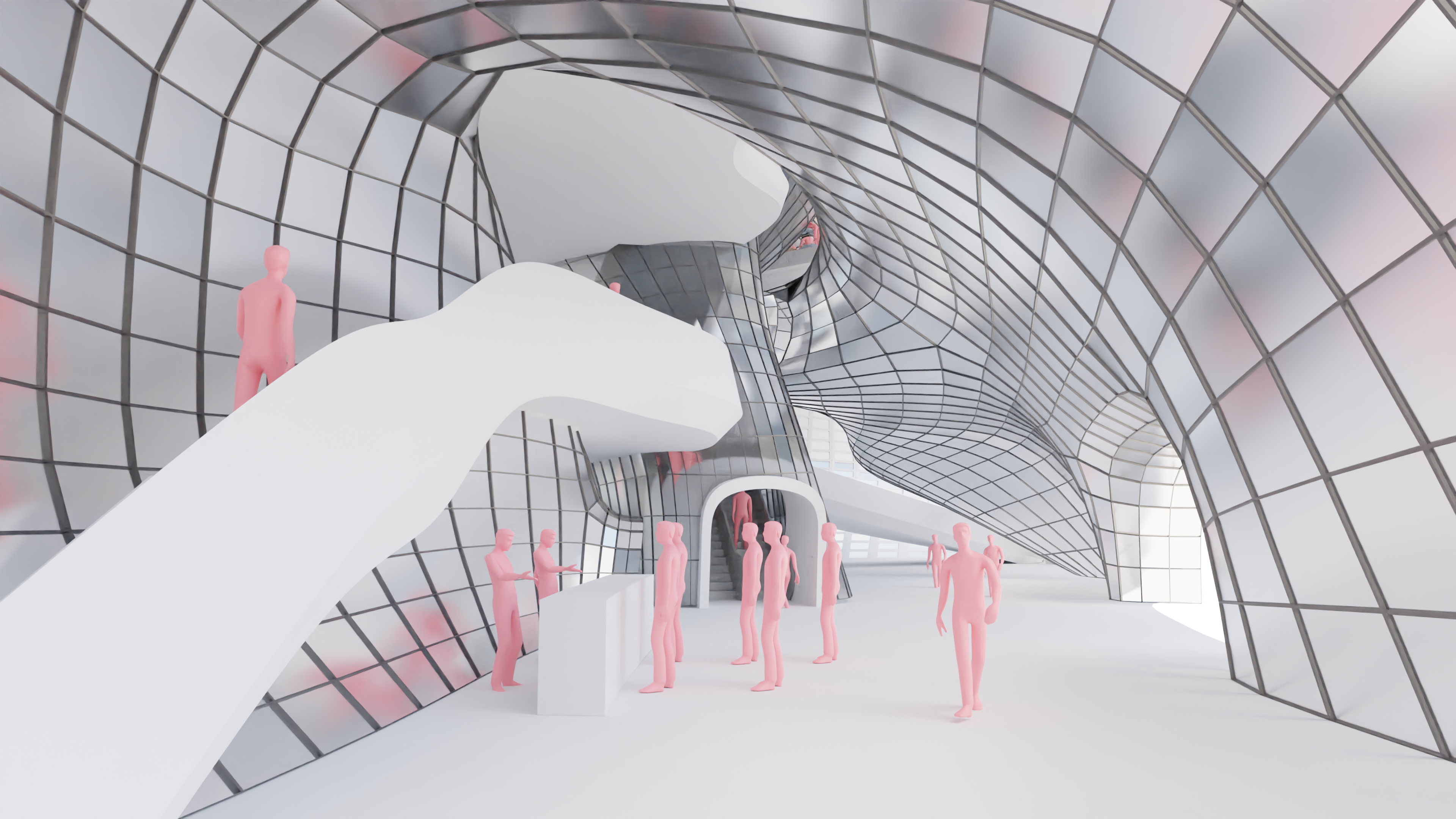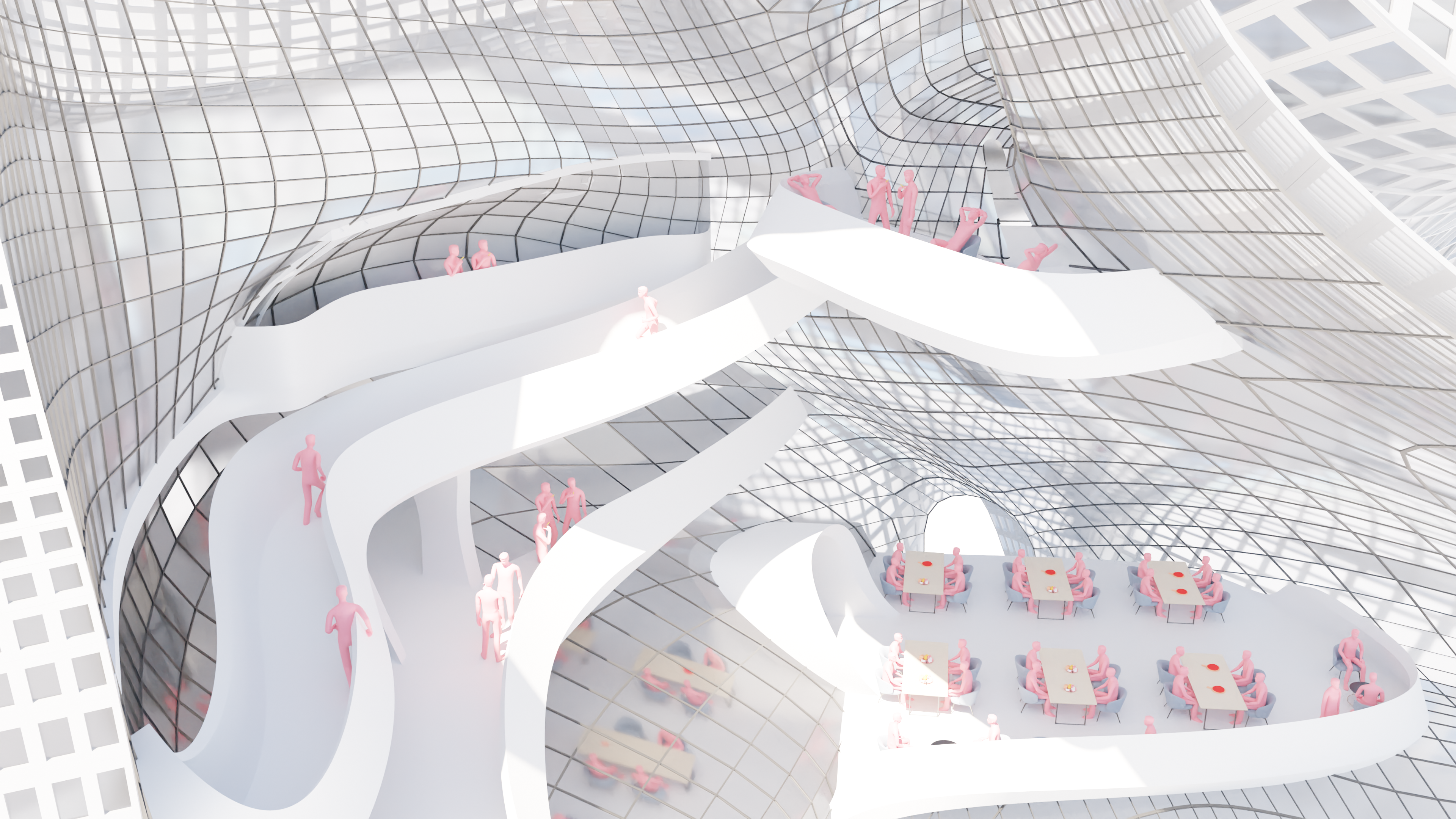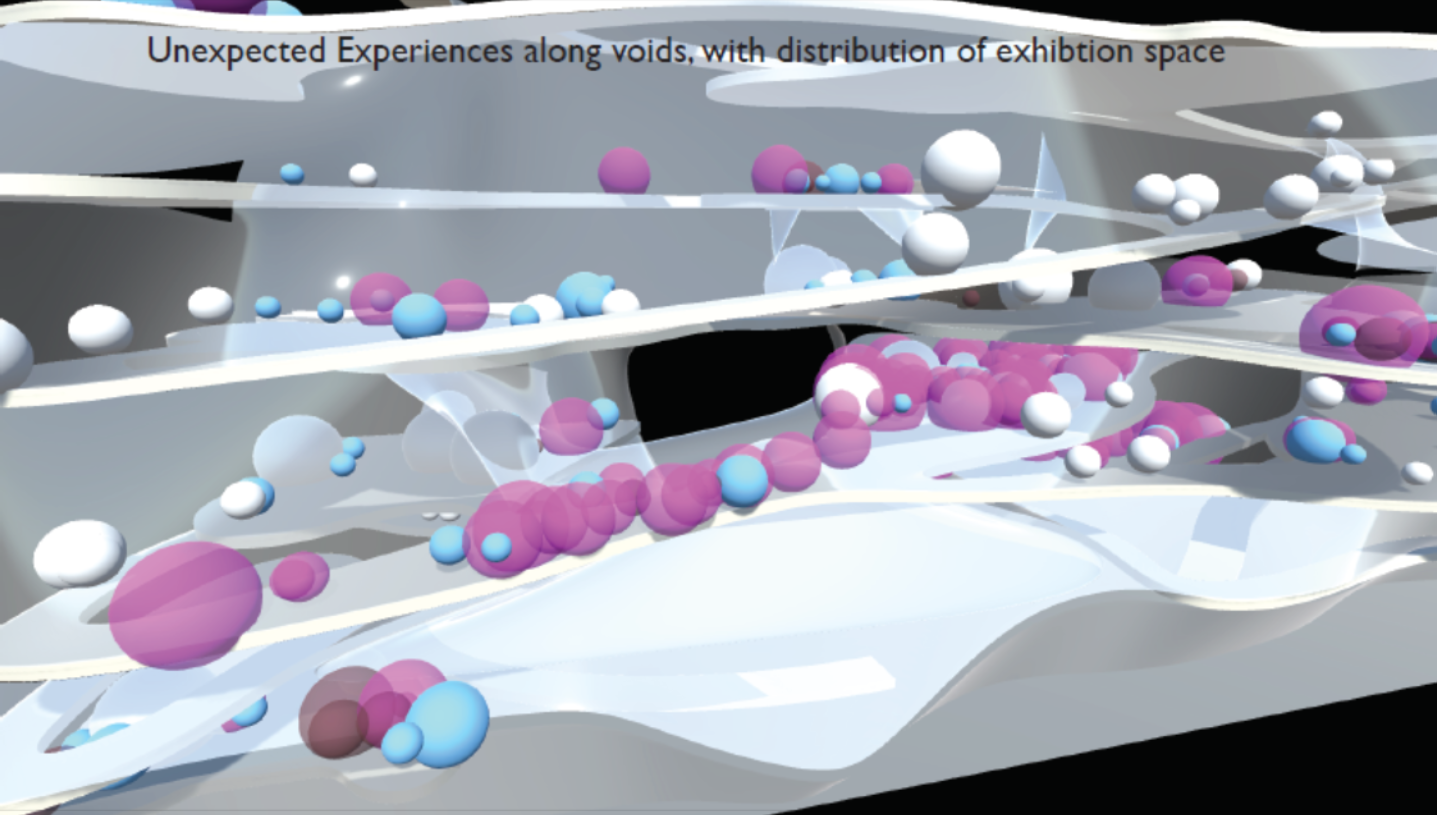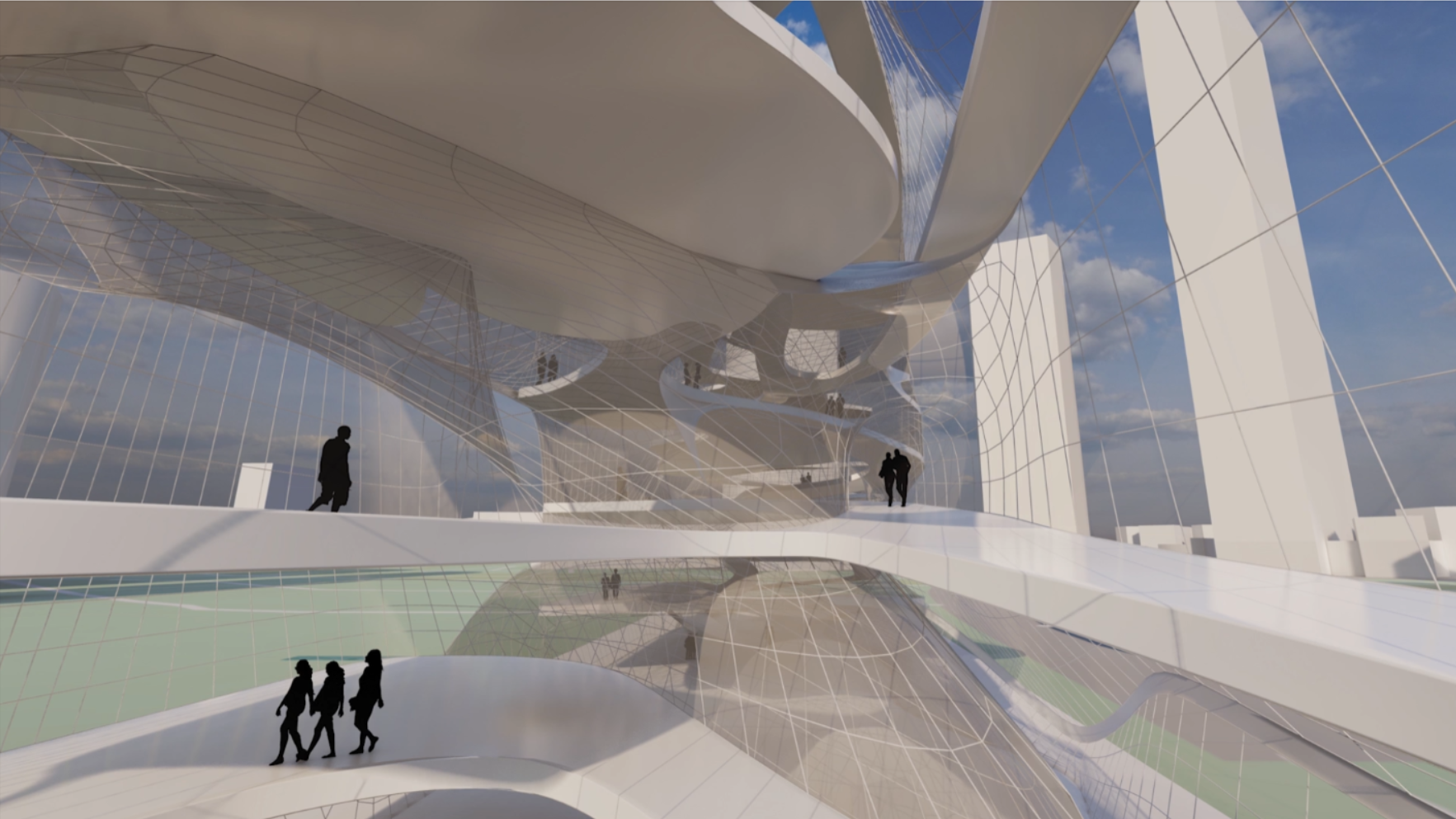Advect People
Design Studio
Studio Greg Lynn, Die Angewandte
Design Studio
Studio Greg Lynn, Die Angewandte
Students: Hao Wu,
Benedikt Schambeck
Supervisor: Greg Lynn
Teaching Assistants: Maja Ozvaldic, Bence Pap and Kaiho Yu
Guests: Elena Manferdini
![]()
Studio Brief
This semester we will work with a very new understanding of site and program.
In the best case, it is typical to loosely define shapes based on areas and position them in terms of adjacencies so that architecture is thought in terms of room plans. Instead of defining activities with areas, for example in square meters and clear height requirements, we will define activities as duration of movement, for example how slowly someone moves for a duration of time defining a location.
The organization plan is defined by functions arranged adjacent to one another with paths through and between them. Instead of paths connecting functions, for example with circulation, we will quantify different durations of movement (duration is the distance travelled over time as a method of defining space rather than as static dimensions) by defining agents with modulating velocity. It is important not to think of stasis and circulation as two modes but instead a continuity.
The curriculum this semester will be based on an understanding that program is not areas and adjacencies; program is an algorithm.
Concept Statement
The project is organized around social “voids” (spaces of affordances) using ML-Agents and CFD simulation to negotiate ventilation, social interaction, orientation, and encourages unexpected activities. Agents define occupiable space by their duration of stay, while a Reinforcement learning algorithm negotiates voids maximizing visual proximity and flows through the building.
Teamwork Credits
Concept Design
Scripting of Unity ML-Agent Voxels
Scripting of Agent-Based Simulation in Unity
3D Modeling of Spatial Voids
Air Form Finding with OpenVDB(Houdini)
Scripting of AR application
Design Tools
3D Modeling: Rhino, Maya, Blender, Houdini
Form Finding: OpenVDB(Houdini), Grasshopper
Air Simulation: Pyro(Houdini)
People Simulation: Unity, BehaviorDesigner
Rendering: Cycle(Blender)
Animation: Cycle(Blender), Redshift(Houdini) Application Build: Xcode, on iPadOS/iOS
Augmented Reality: Vuforia Engine
Supervisor: Greg Lynn
Teaching Assistants: Maja Ozvaldic, Bence Pap and Kaiho Yu
Guests: Elena Manferdini

Studio Brief
This semester we will work with a very new understanding of site and program.
In the best case, it is typical to loosely define shapes based on areas and position them in terms of adjacencies so that architecture is thought in terms of room plans. Instead of defining activities with areas, for example in square meters and clear height requirements, we will define activities as duration of movement, for example how slowly someone moves for a duration of time defining a location.
The organization plan is defined by functions arranged adjacent to one another with paths through and between them. Instead of paths connecting functions, for example with circulation, we will quantify different durations of movement (duration is the distance travelled over time as a method of defining space rather than as static dimensions) by defining agents with modulating velocity. It is important not to think of stasis and circulation as two modes but instead a continuity.
The curriculum this semester will be based on an understanding that program is not areas and adjacencies; program is an algorithm.
Concept Statement
The project is organized around social “voids” (spaces of affordances) using ML-Agents and CFD simulation to negotiate ventilation, social interaction, orientation, and encourages unexpected activities. Agents define occupiable space by their duration of stay, while a Reinforcement learning algorithm negotiates voids maximizing visual proximity and flows through the building.
Teamwork Credits
Concept Design
Scripting of Unity ML-Agent Voxels
Scripting of Agent-Based Simulation in Unity
3D Modeling of Spatial Voids
Air Form Finding with OpenVDB(Houdini)
Scripting of AR application
Design Tools
3D Modeling: Rhino, Maya, Blender, Houdini
Form Finding: OpenVDB(Houdini), Grasshopper
Air Simulation: Pyro(Houdini)
People Simulation: Unity, BehaviorDesigner
Rendering: Cycle(Blender)
Animation: Cycle(Blender), Redshift(Houdini) Application Build: Xcode, on iPadOS/iOS
Augmented Reality: Vuforia Engine
Concept Video
Augmented Reality Agent-based Simulation on Physical Model(Void part)
CFD simulation on Plan
Final Renderings






Midterm Review Video
Generate 2D Voids by Unity ML Agent(Reinforcement Learning)
There're four types of agents: co-worker, conference visitor, explorer and staff(WIP) and four types of breadcrumbs: working, generic, entertainment and services(WIP). Their relationship are shown here.
To roughly found where we should put those visual connection of void space, We firstly create a 2D abstract space with equal size, and spread three types of breadcrumbs in spatial hierarchy, lower floor and roof for entertainment, higher floor for working. Generics are equally distributed.
Each agent shoot a ray, which represent their sight, crossing the voxel to activities. The voxel is a trained as reinforcement learning agent, which use greyscale to represent the probability of occupiable space and voids. If the agent like the activities and the ray is on voids, or they don't like the activities but the ray is on occupiable space, the reinforcement learning voxel is rewarded. Finally, we got a pixel image that indicates the projection of 3d voids in 2d space.
To roughly found where we should put those visual connection of void space, We firstly create a 2D abstract space with equal size, and spread three types of breadcrumbs in spatial hierarchy, lower floor and roof for entertainment, higher floor for working. Generics are equally distributed.
Each agent shoot a ray, which represent their sight, crossing the voxel to activities. The voxel is a trained as reinforcement learning agent, which use greyscale to represent the probability of occupiable space and voids. If the agent like the activities and the ray is on voids, or they don't like the activities but the ray is on occupiable space, the reinforcement learning voxel is rewarded. Finally, we got a pixel image that indicates the projection of 3d voids in 2d space.
Generate 3D Space by Air Form Finding + Agent Simualtion
We defined 3 steps to create geometries, which we combined at the end. The first step was to get the generated voids from the unfolded plane into 3d. That happens through folding the floors. To create void spaces, we extruded the voids and rotate them in a way, that they are connected. To provide a better air circulation through the building, the voids were combined in a smooth mesh.
As a second step, we designed, based on the 3d projected voids, the circulation of air as force field, and use last semester's form finding process to get surfaces that can achieve expected ventilation performance.
As the last step we run an agent based simulation through the unfolded plane to generate the areas for our program and the circulation. The larger the sphere is, the more time the agent spend there doing a program. With this information we created our areas. To define exact shapes of the slabs we overlaid it with a vector field and take this geometry. We used the same technique of the folding to bring the slabs into 3d. After that we connected the slabs with ramps based on the main circulation given by the simulation. As I mentioned before, at the end we combined all this steps into one geometry.
As a second step, we designed, based on the 3d projected voids, the circulation of air as force field, and use last semester's form finding process to get surfaces that can achieve expected ventilation performance.
As the last step we run an agent based simulation through the unfolded plane to generate the areas for our program and the circulation. The larger the sphere is, the more time the agent spend there doing a program. With this information we created our areas. To define exact shapes of the slabs we overlaid it with a vector field and take this geometry. We used the same technique of the folding to bring the slabs into 3d. After that we connected the slabs with ramps based on the main circulation given by the simulation. As I mentioned before, at the end we combined all this steps into one geometry.
Duration Concept
Each agent holds a schedule list. They decide which breadcrumb as their activities by evaluating the air condition and historical usage of the breadcrumb.
If they saw better condition, for example, eating in interior but feels breeze outside, they change indoor eating to al fresco, or see many people dancing at bar, then change next activity from gym to bar. We call it 'found unexpected experience'. A co-working agent A smokes with another agent B at common room, or A found B is reading the same book at library, they decide to work together, we call this 'social interaction', and A is going to copy B's schedule list of the rest day.
As you can see from the dashboard, solid white spheres mostly along the voids are the 'found unexpected experience', solid blue spheres in cafe and etc. are the 'social interaction'. When agents arrived at the targets, how long they stay depend on the air quality and surrounding crowd density, their duration can be longer, or shorter. Duration is represented in sphere's diameter
If they saw better condition, for example, eating in interior but feels breeze outside, they change indoor eating to al fresco, or see many people dancing at bar, then change next activity from gym to bar. We call it 'found unexpected experience'. A co-working agent A smokes with another agent B at common room, or A found B is reading the same book at library, they decide to work together, we call this 'social interaction', and A is going to copy B's schedule list of the rest day.
As you can see from the dashboard, solid white spheres mostly along the voids are the 'found unexpected experience', solid blue spheres in cafe and etc. are the 'social interaction'. When agents arrived at the targets, how long they stay depend on the air quality and surrounding crowd density, their duration can be longer, or shorter. Duration is represented in sphere's diameter
Organization Strategy






Spatial Experience



All right received